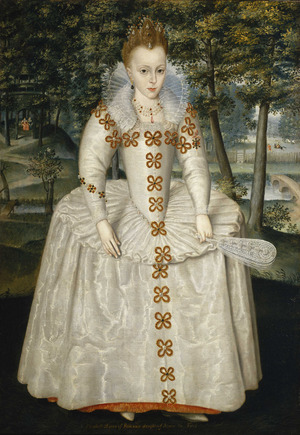Blanche Swansted facts for kids
Blanche Swansted was a skilled hairdresser and a "tirewoman" (someone who helped style hair) for important royal ladies. She worked for Elizabeth I, who was Queen of England, and then for Anne of Denmark, who became Queen when she married James VI and I. Later, Blanche also styled the hair of Princess Elizabeth, who was the daughter of Anne and James.
In 1603, Blanche Swansted traveled to Berwick-upon-Tweed, a town near the border between England and Scotland. She went there to meet Anne of Denmark, who was on her way to become the new Queen of England.
Contents
Who Was Blanche Swansted?
Blanche Swansted was a very important person in the royal households because she was in charge of hair styling. She helped create the fancy hairstyles that were popular during the 1600s. Her job was to make sure the queens and princesses looked their best for official events and portraits.
What Was a "Tire"?
A "tire" was a special decoration for hair. It often included a wire frame to give hair shape, along with beautiful jewels and ribbons. Imagine a fancy headband or a hairpiece that made hairstyles look much bigger and more elaborate!
Much of what we know about Blanche Swansted comes from official requests she made for payment. These requests, called petitions, were written after Queen Anne of Denmark passed away in 1619. Blanche had also been a tirewoman for Princess Elizabeth and earned about 2 shillings every day for her work.
Styling Queens and Princesses
A document found in The National Archives tells us more about Blanche's career. In 1603, when King James VI of Scotland also became King James I of England (an event called the Union of Crowns), he traveled to London. He left his wife, Anne of Denmark, and their children in Scotland.
A Special Journey for the Queen
In April 1603, King James ordered that some of Queen Elizabeth I's jewels and a hairdresser, Blanche Swansted, should be sent to Berwick-upon-Tweed. The King wanted Anne of Denmark to look like an English queen as she crossed the border into England. He repeated this request, saying the jewels should be chosen by Elizabeth's staff for Anne's "ordinary apparelling and ornament" (her everyday clothes and decorations).
Blanche Swansted's request for payment explains that she traveled north to meet the new queen. She then joined Queen Anne's staff as her "tirewoman in ordinary," meaning she was a regular, official hairdresser.
Life in the Royal Household
A young Scottish woman who worked in Princess Elizabeth's household in England, probably named Anne Livingstone, kept a record of her expenses. She wore similar hairstyles to the Princess. Her notes show she bought "a tire of pearl to wear on my head" and "a wire to my head with nine peaks." She also bought "a periwig of hair to cover the wire" and "a French wire to my head with a hoop of hair."
She paid for these hair "dressings" to be made with emeralds, pearls, garnets, green silk, and feathers. The pearls and precious stones belonged to her. Blanche Swansted or another tire-maker would charge between 9 and 20 shillings to make these dressings, depending on how many extra materials they added and sold. Blanche Swansted's yearly salary in Princess Elizabeth's household was £9, 2 shillings, and 6 pence.
Hair Fashion of the 1600s
In December 1617, a visitor from Venice named Piero Contarini described Queen Anne of Denmark's appearance at Somerset House. Her hair was styled with diamonds and other jewels. It was arranged to spread out like rays or the petals of a sunflower, often with extra artificial hair to make it look fuller. This shows how elaborate and artistic royal hairstyles were during this time, thanks to skilled people like Blanche Swansted.


